How to Decorate with Indoor Plants to Create an Inviting Space (original) (raw)
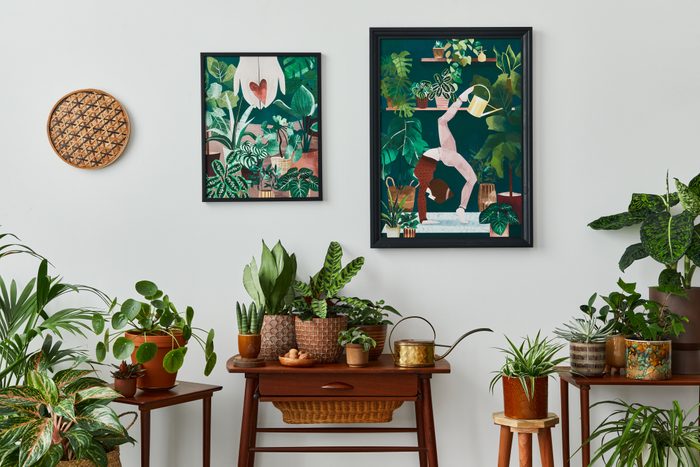
FollowTheFlow/Getty Images
Decorating with plants
Maybe you scour home decor magazines and pin your way through Pinterest, looking for just the right combination of furnishings, color schemes and accent pieces for your everyday living spaces. But are you overlooking a major design element—one that doesn’t involve committing to an expensive couch or a wall color you’ll soon tire of? Look no further than the humble houseplant. Decorating with plants is a fun, creative and usually inexpensive way to enliven—literally and figuratively—your domestic spaces.
“Plants are the best way I know of to add life to a space,” says Justin Lievano, lead florist at UrbanStems. “Introducing plants to any decorating scheme immediately makes a space feel fresher and less sterile.” Plus, as Lievano points out, studies have shown that keeping and tending to plants is good for our mental health—and many plants act as indoor air purifiers too. By making us feel better all around, having plants, Lievano says, “enhances our ability to enjoy a well-curated space.”
When it comes to decorating with indoor plants, Lievano says there aren’t any hard-and-fast rules. “Your relationship with plants should be about what you love and what plants will thrive in your space,” he says. So as you shop for plants, either in garden centers or from online plant retailers, think about your setting, as well as the greenness of your thumb. You may want to start with some low-maintenance indoor plants, or shop for plants that do better in low light.
To provide some design inspo, let’s look at some ideas on how to arrange plants and make decorating with plants an integral part of your overall interior design strategy.

Delmaine Donson/Getty Images
Think texture and variety
Just as you don’t want every texture in your living room to be the same, so it goes with plants. “Given that most plants are some shade of green,” says Lievano, “the best way to create visual interest is with form and texture. By varying the foliage in a room, he says, “you can really add interest and visual richness. For example, the broad glossy leaves of a rubber ficus next to the cute bright foliage of a Chinese money plant are instantly pleasing for the eye.
We love that the designer fully committed here—the assemblage of plants against the orange wall is the focal point of the room.
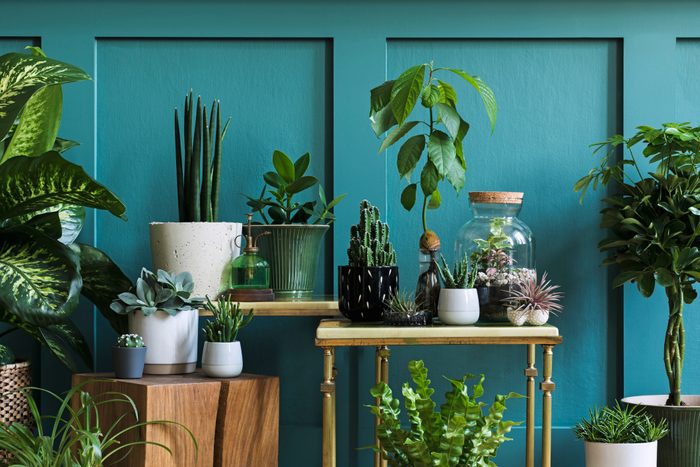
FollowTheFlow/Getty Images
Make plants part of a color scheme
With their varied shades of green, as well as yellow, white, red or variegated leaves, plants can add pops of color to any corner of the home. But they’re not just accents. Consider this arrangement of plants in different shades of green against a bold teal-blue wall. No artwork needed, and not a matching pillow in sight! Succulent sedum dasyphyllum has a pretty, dusty blue-green color, while alocasias come in a huge range of variegated to dark-green shades. Caring for succulents can be harder than you might think, so be sure to read up on how to take care of them.
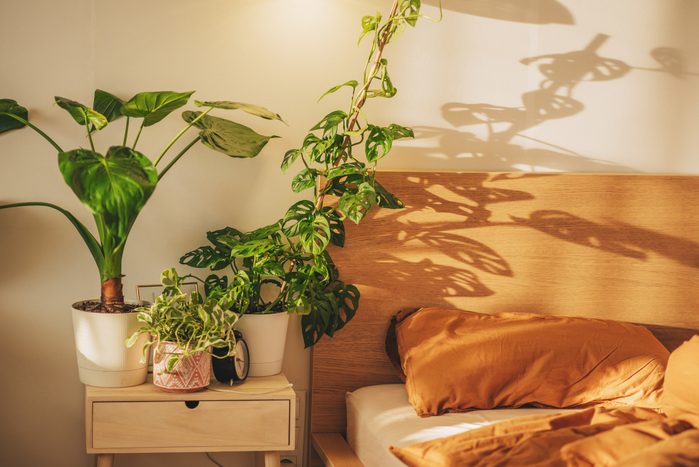
Kseniya Ovchinnikova/Getty Images
Wake up to wellness
Many types of plants are known for their air-purifying qualities. So by putting plants at your bedside, you not only wake up to a cheerful scene before you, you’ll have had a healthier sleep, thanks to a nightstand full of VOC-filtering green helpers. According to NASA, the best air-filtering plants include peace lilies, corn plants and heart-leaf philodendrons.
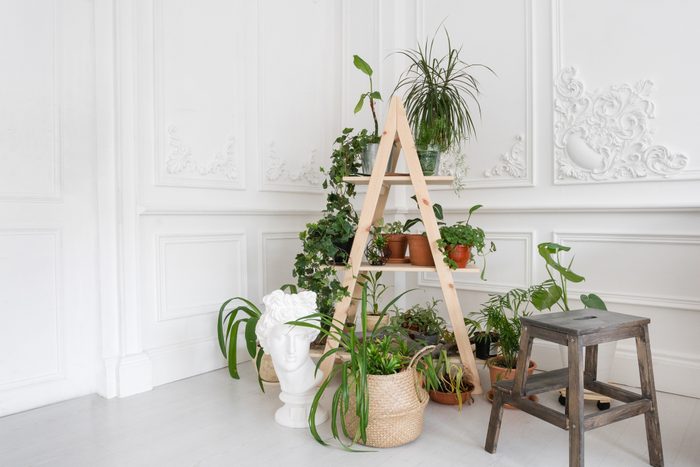
Malkovstock/Getty Images
Combine styles
We love the combination of classic white ornamental plasterwork, rustic plant stands and, of course, the green flash the plants provide. Lievano says that when decorating with plants, it’s important to think about visual balance. “If you have a large floor plant in one corner of the room, it will be really eye-catching, and smaller plants in the same space may go unnoticed,” he says. The wooden plant shelf pictured here allows for similarly sized plants to grab equal attention.
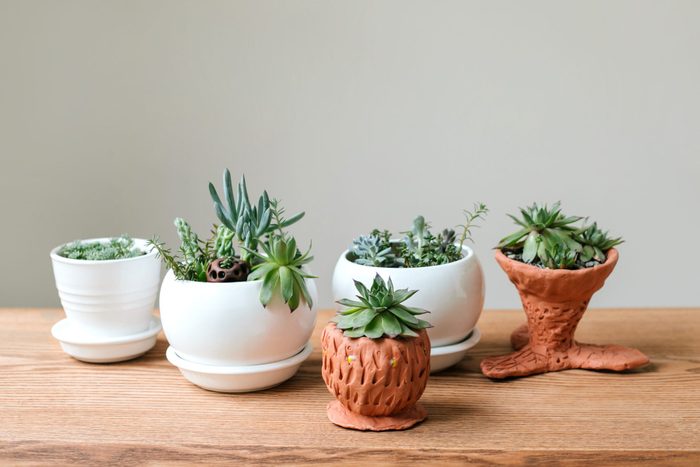
Evgeniia Siiankovskaia/Getty Images
Think small
Apartment dwellers or those with small spaces to work with can still decorate with plants. “A little collection of potted plants near a window (maybe spread across a table, the windowsill or hanging nearby) allows each plant the attention and space it needs to shine,” says Lievano. “Interesting vases and contrasting forms and textures make this succulent assemblage cheerful in a small area.”
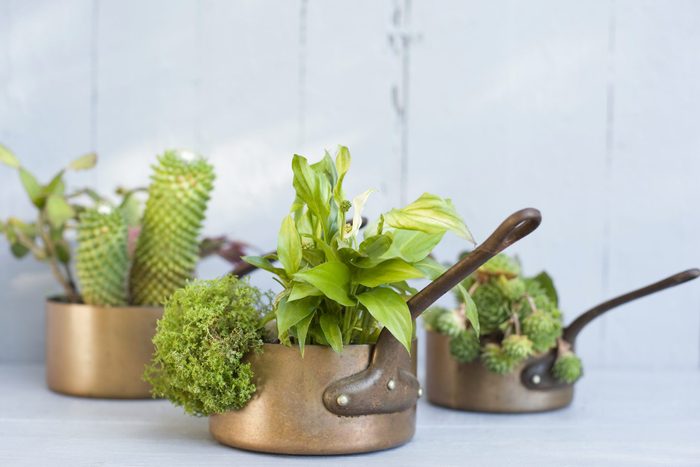
Westend61/Getty Images
Go for the unexpected
Talk about upcycling! This clever use of old copper pans as plant holders is proof that there are ways to reuse just about every item. The copper creates a nice contrast against the green foliage too. For a set-up like this one, it’s better to use succulent plants or epiphytes that need to be watered infrequently. Otherwise, keep the plants in small plastic vases that are lower than the rim of the copper pot so you can take them out for watering.
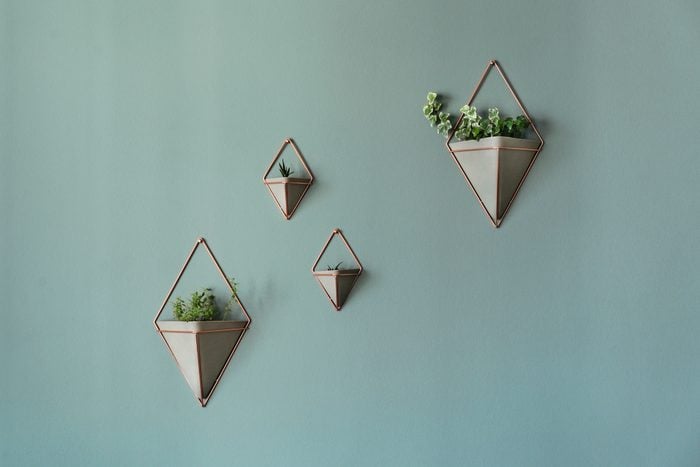
Polonina Irina/Getty Images
Create wall art with plants
What a simple, elegant idea. Instead of hanging photos or artwork on a wall, decorate with plants. These triangular hanging vases are designed to sit flush against a wall, creating a look that’s 3D yet low-profile at the same time. Once again, succulents are a good option here, as are air plants that don’t need watering. Play around with different vase shapes and sizes to create your own “work of (plant) art.”
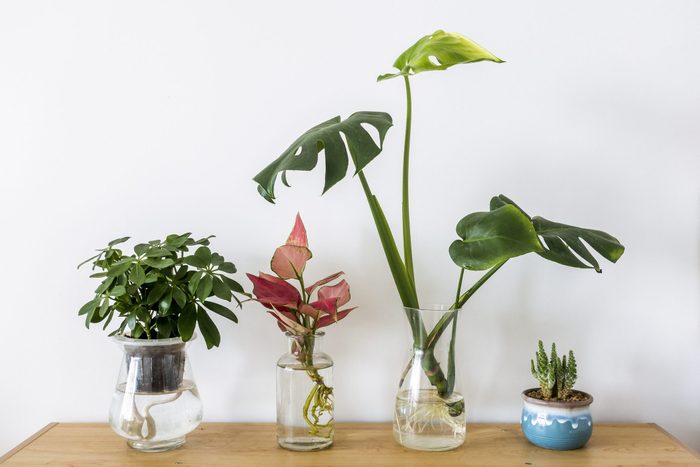
DuKai photographer/Getty Images
Skip the soil
If concerns over messy potting soil have kept you from decorating with plants, consider growing plants that can thrive in water, bark, moss or on lava rock. Pothos, philodendrons and most plants from the aroid family, as well as several varieties of ivy, can grow in water, or as hydroponics. Just be sure to change the water every couple of weeks. Orchids, like other epiphytes (air plants), can grow in bark, moss or attached to a piece of a tree stump or lava rock.
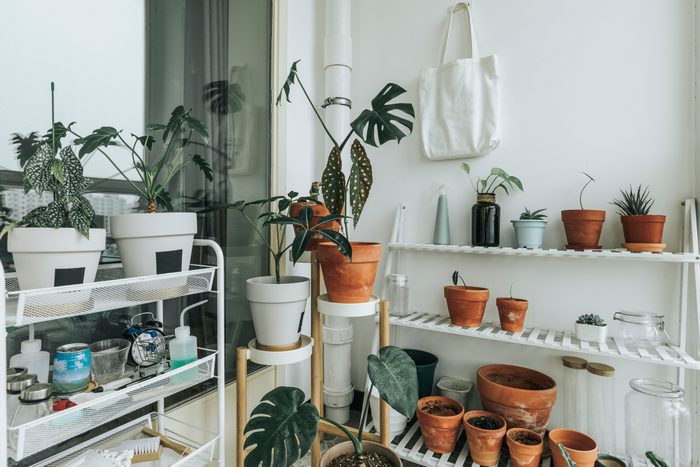
DuKai photographer/Getty Images
Create a hobby corner
If puttering with plants is your passion, convert a section of an indoor or covered outdoor living area into a potting corner. If you commit to keeping your space orderly, with some nice shelving and a few plant stands, a gardening corner can be a pleasant addition to your home and a place that will provide lots of enjoyment to you and spark interest among guests who visit.
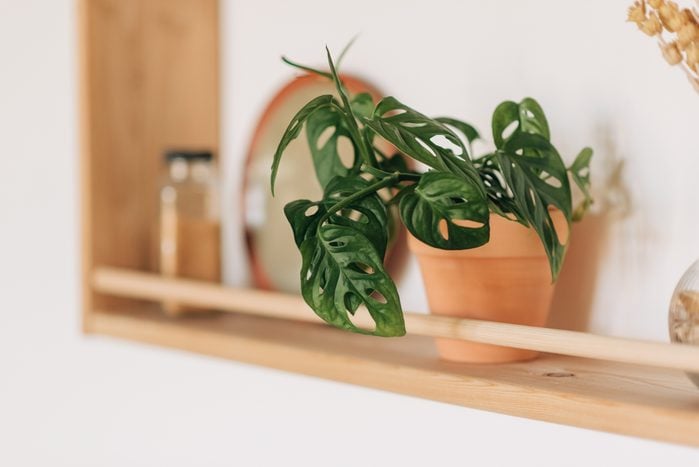
Kseniya Ovchinnikova/Getty Images
Brighten up a kitchen
Whether your kitchen is modern or classic, a green plant or two, even on a small shelf over the sink or tucked into the spice rack, will add color and cheer. To keep a plant from taking over valuable counter space or growing dangerously close to heat sources, stick with smaller plants or those that can easily be cut—with golden pothos, for example, you can keep growing new plants from its cuttings. The top of the fridge is a great place for a larger climbing or cascading plant. Or just stick to an indoor herb garden on a windowsill.
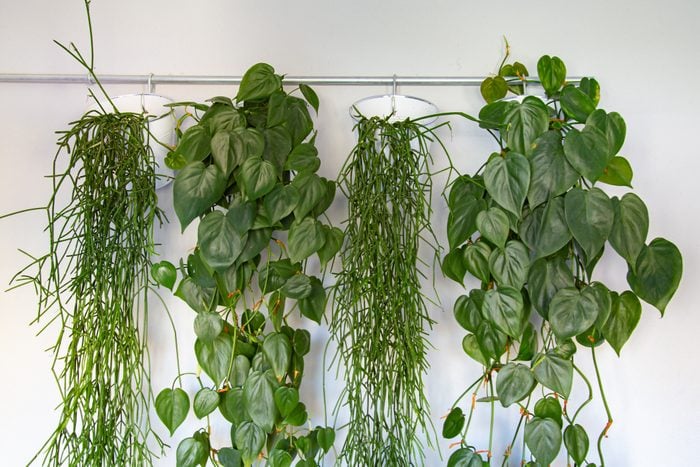
HildaWeges/Getty Images
Look up!
Lush, cascading hanging plants are a great option for hanging above eye level. They’ll fill a bare wall or corner and, with the right play of shapes and textures, will create visual interest, as in this alternating arrangement of mistletoe cactus and heart leaf philodendron. Just make sure you have a step stool handy for watering! This is another nice example of what looks like upcycled materials—with vintage enamel containers repurposed as planters.
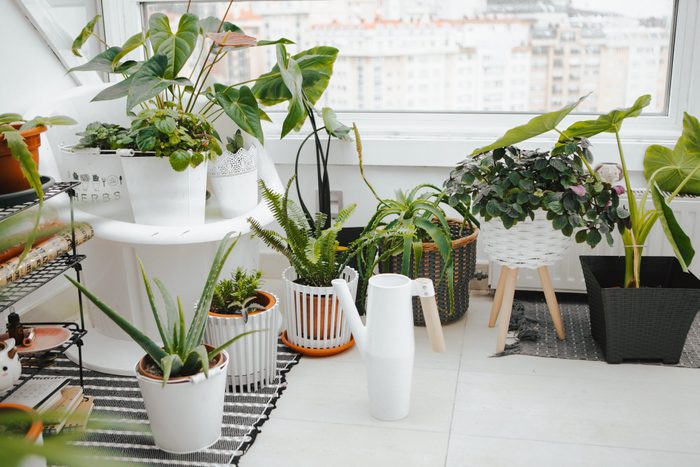
Carol Yepes/Getty Images
Let there be light
If you have a too-bright corner, a sunroom or a low-ceilinged space that’s otherwise wasted, fill it with plants! By using mostly white containers and playing with heights and texture, this plant lover has taken a corner that might not have been comfortable as a sitting space and turned it into a restful green haven. And those inexpensive rag rugs can be tossed in the washer if they get stained or dirty. Just be sure the plants will thrive with full sun. If you’re not sure what that means, find out in our plant lighting guide.
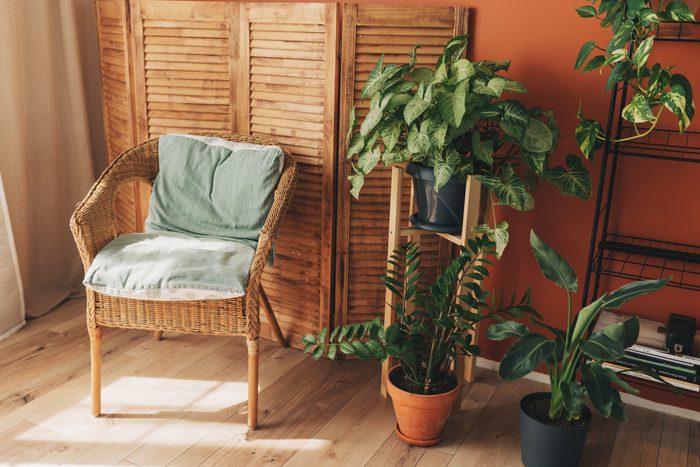
Kseniya Ovchinnikova/Getty Images
Create a cozy nook
The soothing ocher, wicker and wood tones in this little corner make us want to escape here with a good book—or just sit and talk to the plants! Again, this is an example of how plants set at varying heights can fill a “dead” space that might otherwise be hard to activate. This is a potentially inexpensive solution too, if you hunt thrift stores for a vintage chair and folding screen and stick with a simple wooden plant stand.
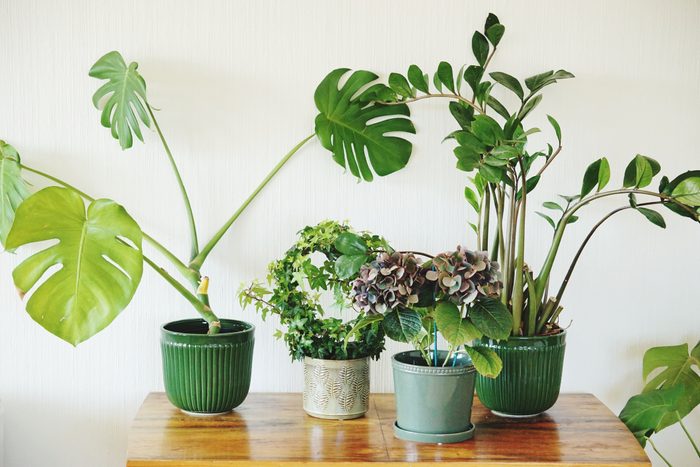
Merethe Svarstad Eeg/Getty Images
Use beautiful containers
One hot tip for decorating with plants? “Containers!” says Lievano. “Stylish containers are a great way to marry your plants with your decor.” For pretty containers, it’s worth checking out local resale shops and discount home stores like HomeGoods. Lievano recommends leaving your plants in their grow pots and dropping those into containers and baskets. “This lets you treat the pot like clothes that you can change when you need to,” he says, “and it makes moving your plants much easier.”
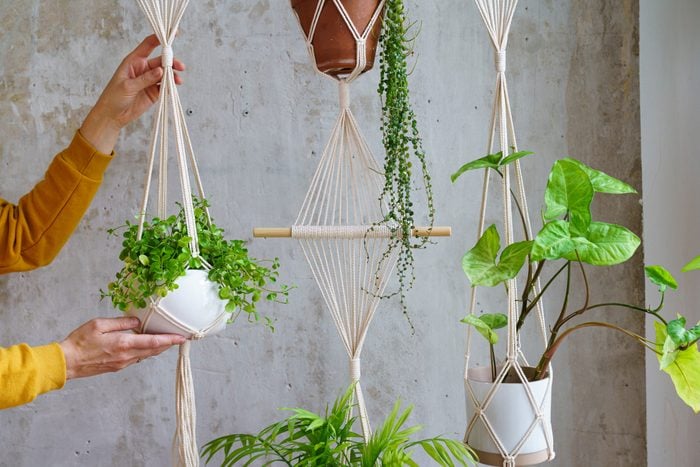
Dima Berlin/Getty Images
Remember macramé?
If you came of age in the 1980s, you probably remember the macramé craze, when plant holders, wall hangings, purses and even clothing were being knotted out of macramé jute. While those macramé purses may be out of style, macramé plant holders are just as fun and functional as they were last century. Buy inexpensive versions on Amazon, or learn to make your own.
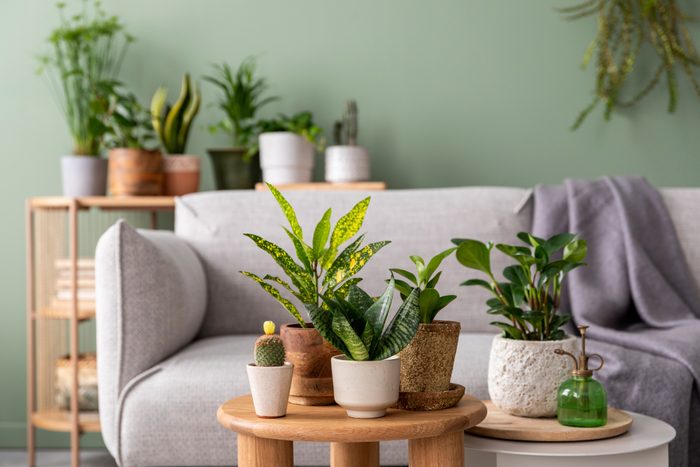
FollowTheFlow/Getty Images
Swap tchotchkes for plants
Instead of cluttering a coffee table, end table or shelf with whatnots, why not make plants the conversation pieces of your living room? Think of all the elements you can incorporate—different colors, shapes and textures of foliage, a variety of vases and other containers. Together, they impart a fresh look in your living area, and they won’t gather quite so much dust! These are our favorite living room plants.
Source:
Justin Lievano, lead florist at UrbanStems